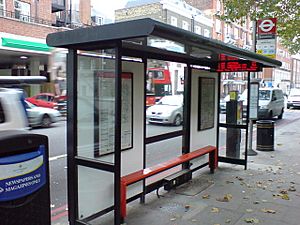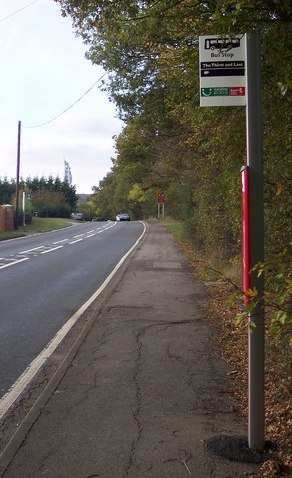Bus stop facts for kids
A bus stop is a special place where buses pick up and drop off passengers. Think of it as a designated spot on the road where you wait for your bus. Some bus stops in busy areas have cool features like shelters to protect you from rain or sun, seats to rest on, and even electronic screens that tell you when the next bus will arrive. Simpler bus stops might just have a pole with a sign to show you where to wait.
Contents
What You'll Find at a Bus Stop
Bus stops come in many shapes and sizes, but most have some common features to help passengers.
Shelters and Seating
Many bus stops, especially in cities or busy areas, have shelters. These are like small buildings or roofs that protect you from bad weather, whether it's pouring rain or a hot sunny day. Inside or near the shelter, you often find seats where you can relax while waiting for your bus.
Information Boards
At almost every bus stop, you'll see signs or boards that give you important information. These usually include:
- Bus route numbers: These tell you which buses stop at that particular spot.
- Timetables: These show you when buses are expected to arrive.
- Maps: Sometimes, there are maps that show the bus routes and where they go.
- Notices: You might also see notices about changes to bus services or special events.
Electronic Information Systems
Some modern bus stops have electronic screens. These screens are super helpful because they show real-time information. This means you can see exactly when your bus is coming, even if it's running a little late. This technology helps you plan your journey better.
Other Features
Depending on the location, a bus stop might also have:
- Litter bins: To help keep the area clean.
- Lighting: To make the stop safe and visible at night.
- Accessibility features: Such as ramps or raised curbs to make it easier for people using wheelchairs or strollers to get on and off the bus.
Types of Bus Stops
Not all bus stops are the same! They can be designed differently based on how busy they are and where they are located.
Simple Pole Stops
In quieter areas or on less busy routes, a bus stop might just be a simple pole with a sign on top. This sign usually has the bus stop symbol and the bus route numbers that serve that stop. These are very common and easy to spot.
Shelter Stops
As mentioned, these stops have shelters and often seats. They are designed for places where more people wait for buses, offering comfort and protection from the weather.
Bus Stations and Termini
Sometimes, a bus stop is part of a much larger area called a bus station or a bus terminus. These are big hubs where many bus routes start or end. They can have multiple platforms, ticket offices, shops, and waiting areas. Bus stations are like airports for buses!
"Hail and Ride" Areas
In some rural or less populated areas, there might not be fixed bus stops everywhere. Instead, buses operate on a "hail and ride" system. This means you can wave at the bus from a safe spot along its route, and the driver will stop if it's safe to do so. It's like calling a taxi, but for a bus!
How to Use a Bus Stop
Using a bus stop is usually straightforward:
- Find the right stop: Make sure you are at the correct bus stop for the direction you want to travel and the bus route you need.
- Check the information: Look at the signs or electronic displays to confirm the bus number and its arrival time.
- Signal the bus: When your bus approaches, make sure the driver sees you. You might need to wave your hand clearly so they know you want to get on.
- Board the bus: Wait for the bus to come to a complete stop before trying to get on.
Why Bus Stops Are Important
Bus stops play a big role in making public transport work well.
- Organization: They help organize bus routes and make sure buses stop in predictable places. This makes it easier for everyone to use the bus system.
- Safety: Having designated stops means passengers don't have to wait in unsafe places on the road.
- Efficiency: By stopping only at specific points, buses can keep to their schedules better and move more efficiently through traffic.
- Accessibility: Well-designed bus stops can make public transport accessible to more people, including those with disabilities.
Related pages
- Automatic vehicle location
- Bus bulb
- Bus Safety Act
- Bus station
- Bus terminus
- Hail and ride
- Intermodal passenger transport
- Metro station
- Street furniture
- Train station
- Tram stop
- Ticket (admission)
- Wait/walk dilemma
Images for kids
-
A Highway Bus stop in Visakhapatnam, India
-
Bus stop sign in Hamburg with line numbers and major stops
-
In many places, bus stop infrastructure includes bins for litter. Pictured is a rural bus stop in York Region, north of Toronto.
-
A large suburban bus stop in York Region, near Toronto
-
Bus stop info poster in Vancouver, British Columbia also shows rapid transit routes
-
A worn-out "totem" of the ITB near the old town of Bucharest, 1986
-
Metro Transit bus stop shelter (ca. 1980) in Minneapolis, Minnesota, United States
-
Bus stop shelter made from calcium-silicate bricks in Seliste, Estonia
-
Bus stop in Busan, South Korea
-
Bus stop in Seoul, South Korea
See also
 In Spanish: Parada de autobús para niños
In Spanish: Parada de autobús para niños


























